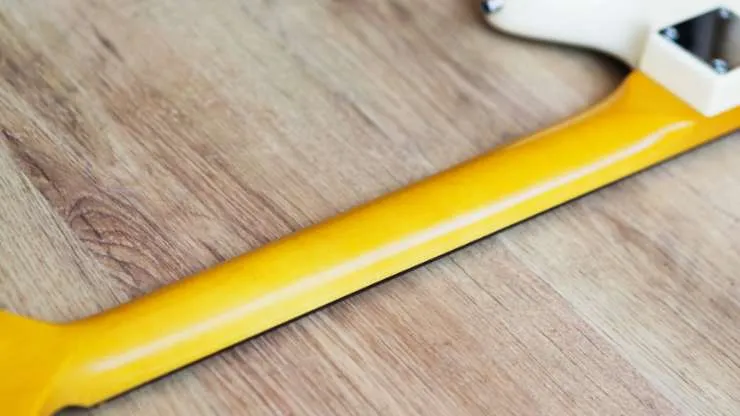When it comes to choosing the right guitar, there are several factors to consider. Many may first look at the body type, the pickups, or maybe even the guitar scale, which are all vital. But one often overlooked area is the guitar’s neck profile. In this article, we’ll review the most common neck profiles and help you decide which guitar neck profile is best for you.
What Is a Neck Profile and Why Does It Matter?
Neck profile refers to the shape and size of the guitar’s neck. While often overlooked, a neck’s profile can significantly affect the playability and comfort of the instrument. Furthermore, depending on how you play and even how big your hands are, specific profiles could be better or worse suited to your particular needs.
It’s important to note that there aren’t any hard and fast rules regarding neck profiles and who can use them. Even if one style is better suited to lead players, it doesn’t mean a soloist couldn’t happily use a different profile. That said, if you are looking to freshen up your playing or haven’t settled on a preferred profile, picking a more favourable neck for your guitar aims could be a great way to advance your licks further.
Do Guitar Neck Profiles Affect Tone?
A guitar’s neck profile has a minimal effect on the sound that an instrument produces – and any difference probably has more to do with how you might play a bit differently when using different neck types. However, some guitarists maintain that thicker and wider neck profiles provide more material and surface area for the strings to vibrate against, resulting in a fuller, more resonant sound. In either case, a neck profile’s most significant impact is certainly playability and comfort.
C-Shape Neck
C-shape necks are arguably the most prevalent neck profile out there. Their rounded shape allows players to maintain a comfortable grip and a smooth playing experience. A well-executed C-shaped guitar neck can help to reduce hand fatigue during extended playing sessions. At the same time, the neck’s curvature also allows for a more natural hand position, which can help prevent cramping or discomfort. Furthermore, the rounded neck shape can make it easier to transition between chords and notes, as your hand can smoothly slide up and down the neck.
C-shape guitar necks can provide more support for your hand while you play, while the neck’s curvature can also help to distribute pressure evenly, reducing the risk of injury or strain. This can be particularly beneficial for those who play frequently or for extended periods.
C-shape necks are perhaps the most versatile options, used by rhythm and lead guitarists alike. However, guitarists who have previously used flatter necks may find that the curvature takes a little getting used to. Additionally, C-shape guitars aren’t optimal for those who trade in shredding solos or fingerstyle playing, where flatter, thinner necks work better.
U-Shape Neck
U-shape necks are often found on vintage guitars like the original Fender Telecasters. Also known as ‘baseball bat’ necks, they are chunky, rounded, and with high shoulders. Given their deeper profile, a U-shape neck is an excellent choice for guitarists with larger hands. Additionally, their shape allows players to maintain a natural hand position, reducing strain and fatigue during extended playing sessions.
These necks are also an excellent pick for rhythm guitarists, with great stability and grip possible on the thicker neck, although they can be challenging to adjust to if you’re used to thinner necks. Furthermore, if you have smaller than average hands (or maybe even average hands), you might find U-shape necks to be a bit of a stretch.
D-Shape Neck
Somewhere between a C-shape and a U-shape neck, D-shape necks feature a flattened mid-section on the back and broad shoulders, but not to the extremes of a U-shape neck. This type of neck is perfect for players who like to keep their thumb firmly in place on the back of the neck and are particularly well-suited to wider-necked instruments, such as classical guitars, and extended-range instruments like 7 or 8-string guitars.
D-shape necks come in different thicknesses. Older instruments typically had a thicker, chunky neck, while modern D-shape necks tend to be slimmer, such as Gibson’s Slim Taper necks and Fender’s Modern D necks. The flattened back and shallower depth of modern D-shape necks allow excellent access to higher frets, making it a great choice for lead players.
V-Shape Neck
One of the least common neck varieties, the V-shape profile certainly divides opinion. Some guitarists find the shape more comfortable and better suited to their playing style, but these guitarists are in the minority! V-shape necks are one of the more vintage options and feature a pointed ‘V’ edge that runs down the back of the neck. These necks are often preferred by players who use their thumbs to play the bass notes of chords.
There are two types of V-shape necks – a hard V, which features a more defined and pointed edge on the back of the neck, and a soft V, which presents a more curved V effect. This neck offers a very different playing experience to the other popular profiles, and it’s one that you should definitely try before you buy – it isn’t to everyone’s tastes. V-shape lovers appreciate the secure grip of the V that suits their preferred play style. On the flip side, other guitarists may find the pointed shape uncomfortable or challenging to play on, especially if they are used to more common neck shapes.
Asymmetrical Profile Neck
While they have an odd, even misshapen appearance, asymmetrical necks are favoured by many musicians. The thinking behind these necks is to mimic the dimensions of a human hand’s grip more closely, resulting in a more comfortable playing experience. Typically, these necks have a thicker profile on the lower string portion while being thinner and more streamlined on the higher strings.
The raised back line can progressively graduate towards the higher strings as you move down the neck in more complex examples of asymmetrical necks. Theoretically, this provides a better grip to support the primary function at each neck location – low strings and chords towards the nut and improved high fret access at the top end.
Given the advanced nature of this profile, Asymmetrical neck guitars are often more premium instruments that command higher prices.
Which Guitar Neck Profile Is Best?
Ultimately, the choice of neck design is a matter of personal preference. If you are a technical lead guitarist who values speed and efficiency, a thinner, flatter profile, like a modern D-shape, could be what you’re looking for. If you have larger hands and like to firmly root your thumb behind the neck, consider a chunky U-shape. But, if you’re new to guitar or play a wide variety of styles, it’s hard to go wrong with a C-shape neck. You’ll have by far the most extensive choice of guitars, and the smooth curves and ergonomic design of these necks can help you play at your best, leaving you to enjoy jamming.
Find Your Guitar?
Now you know precisely what neck profile is the one for you, why not head over to our Finder tool and start the hunt for your perfect guitar? After choosing your must-haves, such as body type, neck profile, and tonewood, you can browse through our pick of the best instruments that tick all the boxes.

